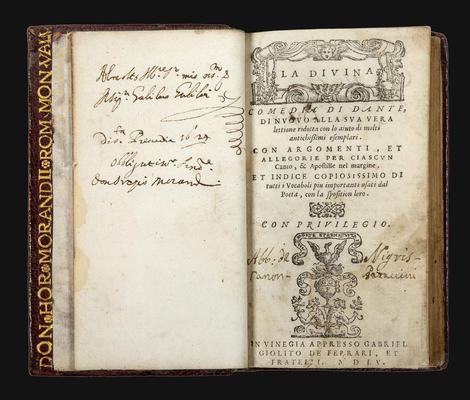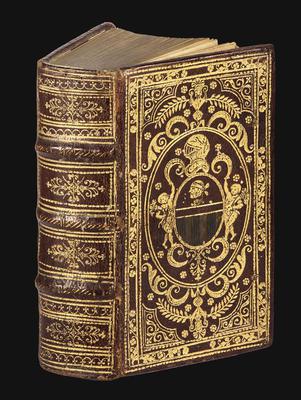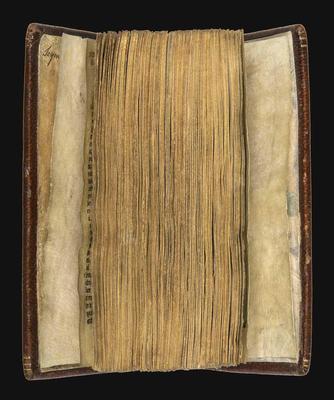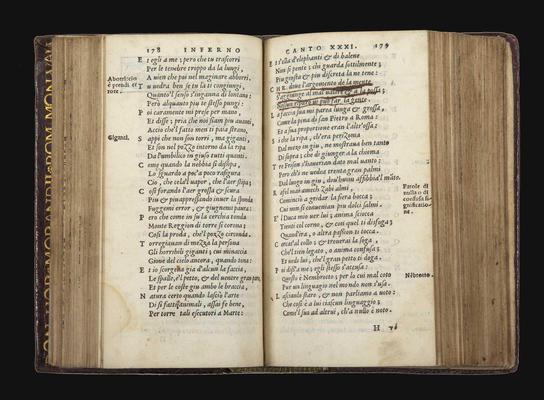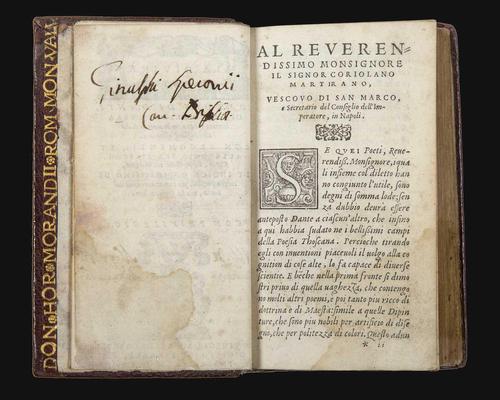Dante Alighieri
La Divina Comedia di Dante, di nuovo alla sua vera lettione ridotta con lo aiuto di molti antichissimi esemplari...
Venice, Gabriel Giolito de' Ferrari and brothers, 1554-1555.12° (125x70 mm). Collation: *12, **6, A-Z12, AA-BB12. [36], 598, [2] pages. Italic and roman type. On the titlepage and on the verso of the last leaf woodcut printer's device. Woodcut medallion portrait of Dante on fol. *3v; twelve woodcuts in text, mostly smaller copies of the woodcuts in the Marcolini edition of 1544. Woodcut initials and headpieces. Fine early seventeenth-century Roman binding executed in the Soresini workshop, red morocco over pasteboards. Covers with elaborate gilt tooling, with fillets, arabesques and volutes, each panel displaying Orazio Morandi's coat of arms. Spine with three raised bands, compartments gilt tooled. On the turn-ins the inscription lettered in gilt ‘don hor morandii rom mon vall' (words separated from each other by a small floral tool). A very fine copy, some printed shoulder notes slightly trimmed. Two underlinings, in two different hands, on fols. *4v and H6r.
Provenance: the Vallombrosan abbot Orazio Morandi (1570-1630; armorial binding); given by Morandi to Galileo Galilei (1564-1642; on the verso of the second front flyleaf ‘Al molto Ill.reS.rmio oss.moIl Sig.rGalilei di s.taPrassedia 1624 Obbligatiss.oServ.reDon Orazio Morandi'); ‘Abb: de Nigris Canon. Patauini' (ownership inscription on the title-page; probably the Paduan canon Giovanni Giacomo Negri, d. 1739); Livio Ambrogio collection.
An exceptional association copy of Lodovico Dolce's Dante – the first edition to apply the adjective ‘Divina' to the Commedia – given in 1624 as a gift to Galileo Galilei by his personal friend and correspondent Orazio Morandi.The friendship between Galileo and the future Vallombrosan abbot of Santa Prassede in Rome – in 1630 accused of practising judicial astrology and imprisoned – must have begun before 1613, perhaps they even got to know each other as children, when they were both being educated at the Camaldolese monastery in Vallombrosa. Only five of Morandi's letters to Galileo have survived, written in 1613, 1626, and 1630 (Galileo's side of the correspondence is entirely lost): the book was in all likelihood given to him between 23 April and 16 June 1624, when the Florentine scientist was in Rome for an audience with Urbanviii(Maffeo Barberini) to discuss the theory of Copernicus. The Giolito Dante is not among the volumes owned by Galileo listed by Antonio Favaro, who identified three Dante editions belonging to the scientist: the Venetian Commedia printed by Ottaviano Scoto in 1484, the Giuntina of 1506 and the Marcolini edition of 1544. This copy of the 1555 Commedia is thus a significant contribution to our still fragmentary knowledge of the books which Morandi and Galileo exchanged. In April 1626 Morandi sent his illustrious friend his copy of Kepler's Hyperaspites, while a copy of the celebrated Saggiatore of 1623, inscribed by Galileo to Morandi, is today in University College London. In the Saggiatore Galileo recalls Dante and his ‘scientific speculations': Morandi's gift of an edition of the Commedia could therefore be related to Galileo's interest in Dante, and especially the topography of Hell. During the winter of 1587-1588 the twenty-three-year old Galileo gave two lectures to the Florentine Academy on the structure, position and dimensions of Dante's Hell or, in his own words, on the description of the ‘infernal theatre', defending the calculations made by Antonio Manetti against the criticisms of Alessandro Vellutello in his commentary on the Commedia published by Marcolini in 1544. The first lecture examines in detail Manetti's description, while the second is dedicated to Vellutello's opinions. Galileo defends the ‘ingenious Manetti' against the calumnies unjustly spread by Vellutello, and demonstrates the accuracy of Manetti's map of the underworld and the scientific validity of his calculations and arguments, qualities which induced Galileo – as he concludes in the first lecture – “not without astonishment, to believe that the opinionof Manetti conforms in everything to the idea of this theatre as conceived by Dante”.In this copy a terzina (verses 55-57) from Cantoxxxiof the Inferno is underlined in an early hand:
ché dove l'argomento de la mente
s'aggiugne al mal volere e la possa,
nessun riparo vi può far la gente.
It is not possible to identify with any certainty the hand which marked this terzina as Galileo's or Morandi's, but it is undeniable that the lines can be read as an assertion of the freedom of thought, and the difficulties encountered when this freedom confronts a blind power (“al mal volere e la possa”, i.e. “ill will and naked force”), both religious and political.On 7 November 1630 the astrologer Orazio Morandi died in obscure circumstances in the Roman prisons of the Inquisition, and it was widely believed he had been poisoned by the authorities; in April 1631 Pope Urbanviiipromulgated the bull Inscrutabilis against astrology. On 22 June 1633 Galileo Galilei recited his solemn abjuration before the Inquisition, and in 1634 his Dialogo sopra i due massimi sistemi was included in the Index of forbidden books, for supporting the theory of Nicolaus Copernicus and discrediting the Ptolemaic model which the Roman Church had maintained over centuries. Even if neither Morandi nor Galileo had personally underlined the terzina, but another early owner instead, nonetheless this feature is both evocative and intriguing, and can be read, possibly, as a homage to a friendship that, for more than thirty years, united – through meetings and conversations, letters and exchanged books – two men who were both persecuted for their opinions. Books which belonged to Galileo are generally of extraordinary rarity and value. Moreover, this copy is in a handsome gilt tooled morocco binding commissioned by Orazio Morandi himself from the Soresini binders, who worked for the papal court and other high-profile clients from the 1590s to ca. 1630. The covers display the coat of arms of the Vallombrosan abbot, with a Moor's head in profile, and the inscription in gilt lettering on the turn-ins – ‘don hor morandii rom mon vall' – clearly revealing Morandi's intention to offer this copy as a gift, in a binding executed for the occasion by one of the most renowned workshops in the papal city.


